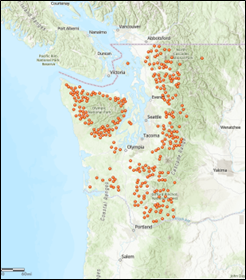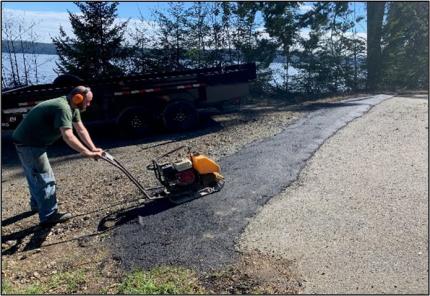Managing Wildlife Populations
Oregon Spotted Frog: Biologist Tirhi completed collecting and entering data for one of three spotted frog breeding sites where habitat restoration is ongoing. Assistant District Biologist Butler collected on the other two. Only those known sites having ongoing habitat restoration were counted in 2023. The balance of this year’s frog time was spent searching for new locations where spotted frogs may be breeding. Water levels were low across all habitats in District 11 this season, which may have affected the number of egg masses that were laid at several sites.

Sooty Grouse Population Monitoring: Biologists Butler and Tirhi spent a day scouting and establishing their assigned sooty grouse survey routes. District 11 has five routes to establish and monitor for 2023, all of which are on Weyerhaeuser property in GMU 667. Tirhi is working with Weyerhaeuser to complete the necessary permits. Meanwhile, Tirhi spent one day, Butler spent one day, and the two together spent a third day beginning to establish the first four routes beginning at the assigned start point. One difficulty they experienced was the late snow conditions across the Cascades Range. The team brought the district’s tracked all-terrain vehicle (ATV) up one day and used it to successfully get above the snowline and establish one full route. Each route has 15 to 30 listening stations, spread one mile apart.



Elk Monitoring: Biologists Butler and Tirhi along with Nisqually Tribe’s Wildlife Program Manager Borrego completed a 4-hour survey of GMU 654 and part of GMU 653 in the North Rainier Elk Herd. GMU 654 has not been surveyed by air in over 30 years and while it was suspected of having fewer elk than surrounding GMUs, the reality was unknown. GMU 653 is known to support the highest number of elk in the herd. The flight team successfully surveyed the entire planned survey area with the available funds. Only 68 elk were observed during the flight, with the majority of those located in the portion of 653 that was flown. This confirms the suspicion that GMU 654 supports fewer elk compared to surrounding GMUs, regardless of the numbers of animals harvested in the fall. These results will allow Biologist Tirhi to better evaluate hunting season levels, the population target in the herd management plan, and provide a valuable missing piece of information in analyzing the herd population trends in GMU 654. WDFW greatly appreciated the United States Forest Services’ Mt. Baker and Snoqualmie national forests who contributed $2000 towards this survey effort.

Streaked Horned Lark: Biologist Tirhi represented WDFW at the annual Larks and Airports Working Group meeting hosted by Federal Aviation Administration (FAA) at the Portland Airport. The meeting included presentations and discussions from various airports in Oregon and Washington that either contain breeding larks or have the potential habitat to support and attract breeding larks. Tirhi presented on the finalization of a Best Management Practices (BMP) document that Tirhi spearheaded with the working group beginning in 2018. The BMPs contain management recommendations addressing all aspects of airport maintenance and development while minimizing impacts to breeding larks.
Providing Recreation Opportunities
Maintenance and Access Projects: The access team performed a wide variety of maintenance tasks with extra emphasis placed on hazardous tree removal, access area driveways, and parking conditions. Gravel and cold patch asphalt were distributed at several sites across Mason, Pierce, Thurston, Kitsap, and Jefferson counties. The access team has also been preparing seasonal lakes for the trout opener on April 22.
Pierce County, Horseshoe Lake: The paved entrance was severely damaged from rainfall nearly three yards of asphalt was needed to bring the Horseshoe Lake approach back into shape.



Pierce County, Jackson Lake: The access team fell two hazardous trees at Jackson Lake, one fir that was heavily leaning over the parking area and a large dead madrone that was a potential hazard over the boat ramp area. Gravel was also placed in washed out areas of the gravel lot. Firewood from the trees was given to the Kitsap Sportsmans Club. Their clubhouse is also located on Jackson Lake.


Kitsap County, Buck Lake: The access team repaired the roadway with gravel, cold patch asphalt, and brushed out the shoulders of the access road.


Jefferson County, Triton Cove: Asphalt repairs were made on the entrance and exit approaches at Triton Cove and Pleasant Harbor’s entrance road and parking area.

Conserving Natural Landscapes
Marrowstone Unit: Technicians Havens and Anderson from the Fish Program assisted Wildlife Area Manager Laushman in installing new signage on Rat Island, part of the North Olympic Wildlife Area, to help discourage summer disturbance of nesting terns and pupping harbor seals.

Bell Creek Unit: Wildlife Area Manager Laushman attended a volunteer event at the Bell Creek Unit of the North Olympic Wildlife Area where volunteers removed protective caging from a large-scale Garry oak restoration project.

South Puget Sound Unit: Technician Morgan mowed about 12 acres of scotch broom at the South Puget Sound Unit in Lakewood, clearing trails and fields that were crowded in by older plants.


Elk Forage Field Maintenance: With the weather becoming more favorable every week, the Olympic Wildlife Area staff members began the annual task of removing broken limbs and branches from the elk forage fields. Using primarily a tractor and chainsaw, Assistant Manager Gallegos and Technician Martinez spent the past several weeks clearing fields in the Wynoochee Mitigation Sites and Olympic Units. Removing the broken limbs and branches is just the first step in the annual maintenance of these fields and allows for more efficient operations the rest of the year, including their cultivation, mowing, and fertilizing. Several of the fields had an abnormally high amount of material, as this task was kept to a minimum last year due to vacant staff positions.


Providing Education and Outreach
Rat Island Volunteer Training: Wildlife Area Manager Laushman coordinated a training for volunteers from the Friends of Fort Flagler, who will serve as docents in the summer months to help educate visitors about nesting Caspian terns and harbor seal haul-outs on the Marrowstone Unit of the North Olympic Wildlife Area. Presentations were given by Research Biologist Pearson, Watchable Wildlife Coordinator Hansen, and Volunteer Coordinator Tilton.

General Wildlife Inquiries: Biologist Murphie responded to inquiries received by phone, email, or in person related to:
- Missing birds.
- Mountain quail.
Conducting Business Operations and Policy
2023-2024 Work Planning: Biologists Tirhi and Butler participated in the Region 6 Wildlife Program/HQ planning meeting. This meeting is held annually to decide what tasks regional district biologists will be doing, how much time will be allocated to each task, in which months, and which funding source will be used. This is done for both game and diversity species work.
Biologist Murphie completed several tasks related to routine operations:
- Vehicle maintenance and upgrades completed this period.
- Taylor’s checkerspot butterfly survey training and prep.
- Elk plan meeting and prep.
- Puget Sound Ecosystem Monitoring Program (PSEMP) survey data error checks.